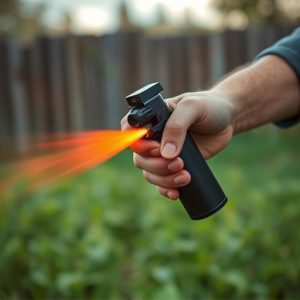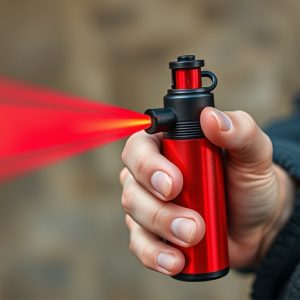Pepper Spray Decontamination: Protecting Your Home After Use
Prompt decontamination is vital after pepper spray exposure to mitigate health risks. For direct con…….
Prompt decontamination is vital after pepper spray exposure to mitigate health risks. For direct contact, rinse skin and eyes with water. Inhale in a ventilated area and apply a cool compress. Proper disposal of contaminated items prevents environmental contamination. Follow these steps at home for safe decontamination from pepper spray incidents.
“In recent years, pepper spray has emerged as a prevalent tool in crowd control tactics employed by law enforcement agencies worldwide. This article delves into the multifaceted aspect of pepper spray, exploring its uses, potential risks, and impact on both human health and the environment. We’ll guide you through when and how police utilize this chemical agent for public safety, followed by essential decontamination steps if you or your family members are exposed. Additionally, we offer practical tips to prepare your home for potential pepper spray situations, emphasizing the crucial role of Pepper Spray Decontamination Steps at Home.”
- Understanding Pepper Spray: Its Uses and Potential Risks
- When and How Police Use Pepper Spray for Crowd Control
- The Impact of Pepper Spray on Human Health and the Environment
- Decontamination Steps After Exposure to Pepper Spray
- Preparing Your Home for Potential Pepper Spray Situations
Understanding Pepper Spray: Its Uses and Potential Risks
Pepper spray, an olfactory weapon that releases a potent chemical agent, is a crowd control tool often employed by law enforcement agencies worldwide. Its primary purpose is to temporarily incapacitate individuals, disrupt violent gatherings, and ensure the safety of both officers and civilians during high-risk situations. The active ingredient in pepper spray, capsaicin, stimulates nerve endings, causing intense pain, tearing, and difficulty breathing, leading to a temporary yet significant disruption.
While effective, pepper spray decontamination steps at home are crucial as its misuse or accidental exposure can lead to adverse health effects. In the event of direct contact with skin or eyes, immediate rinsing with large amounts of water is essential. For inhalation, moving to an area with fresh air and applying a cool compress to the face can aid in recovery. Proper disposal methods are also vital to prevent environmental contamination and potential harm to others.
When and How Police Use Pepper Spray for Crowd Control
When and how do police deploy pepper spray for crowd control? This tactic is often employed in situations where large gatherings pose a potential threat to public safety or when managing protests turn volatile. Pepper spray, or oleoresin capsicum (OC) spray, is designed to incapacitate individuals temporarily through irritation of the eyes, nose, throat, and skin.
The decontamination steps after pepper spray deployment are crucial. Police procedures typically involve directing people away from the affected area and providing access to water for eye flushing and washing any exposed skin. In severe cases or for prolonged exposure, medical attention may be required. Interestingly, while pepper spray is a powerful tool for crowd control, it’s important to note that proper use and decontamination practices are essential to minimize harm and ensure the safety of both officers and civilians alike, especially regarding post-exposure decontamination steps at home if necessary.
The Impact of Pepper Spray on Human Health and the Environment
Pepper spray, while effective for crowd control and security purposes, can have significant impacts on human health and the environment if not used and disposed of properly. When deployed, pepper spray irritates the eyes, nose, throat, and respiratory system, causing temporary but intense discomfort. Prolonged exposure or direct inhalation can lead to more severe health issues, especially in individuals with pre-existing conditions like asthma.
Proper decontamination steps after exposure to pepper spray are crucial. At home, immediate washing of skin and eyes with copious amounts of water is recommended. Inhaling steam or using a humidifier can help ease respiratory irritation. It’s important to note that while these measures can alleviate symptoms, they do not neutralize the chemical agent. Disposing of clothing used during exposure and regularly cleaning surfaces that may have come into contact with pepper spray are essential decontamination practices. Additionally, staying informed about local guidelines for managing pepper spray incidents is vital to ensure both personal safety and environmental protection.
Decontamination Steps After Exposure to Pepper Spray
After exposure to pepper spray, it’s crucial to take immediate decontamination steps to alleviate discomfort and prevent further irritation. Start by moving to a well-ventilated area, as breathing in the spray can cause respiratory distress. Remove any contaminated clothing or accessories, washing them separately from other laundry with hot water and soap to ensure the chemical is thoroughly removed.
For skin contact, gently wash the affected areas with warm water and mild soap. Rinsing with vinegar or a mixture of baking soda and water can also help neutralize the pepper spray residue. If eyes are exposed, flush them immediately with clean, warm water for at least 15 minutes to alleviate stinging or burning sensations. It’s important to perform these decontamination steps at home as soon as possible after exposure to pepper spray.
Preparing Your Home for Potential Pepper Spray Situations
In preparation for potential pepper spray situations, knowing the pepper spray decontamination steps at home is crucial. The first step is to quickly identify and isolate any affected areas within your residence. This involves opening windows and doors to ensure proper ventilation, as good air circulation helps to disperse the pepper spray residue. Using a high-efficiency particulate air (HEPA) filter or a wet cloth can aid in capturing any remaining spray particles.
Once the area is well-ventilated, start the decontamination process by removing all clothing and shoes that may have been exposed to the spray. Place them in sealed plastic bags for safekeeping and later disposal. Next, shower thoroughly with warm water and mild soap, ensuring every part of your body—including hair and skin—is cleaned. Finally, launder any contaminated fabrics separately using hot water and a strong detergent to effectively remove the pepper spray.
In conclusion, while pepper spray can be a valuable tool in police crowd control, it’s crucial to understand its potential risks and properly manage decontamination steps, especially at home. By implementing effective decon measures, as outlined in this article, individuals can minimize the impact of pepper spray exposure and ensure their well-being in such situations. Remember, awareness and preparation are key to navigating these scenarios safely.


